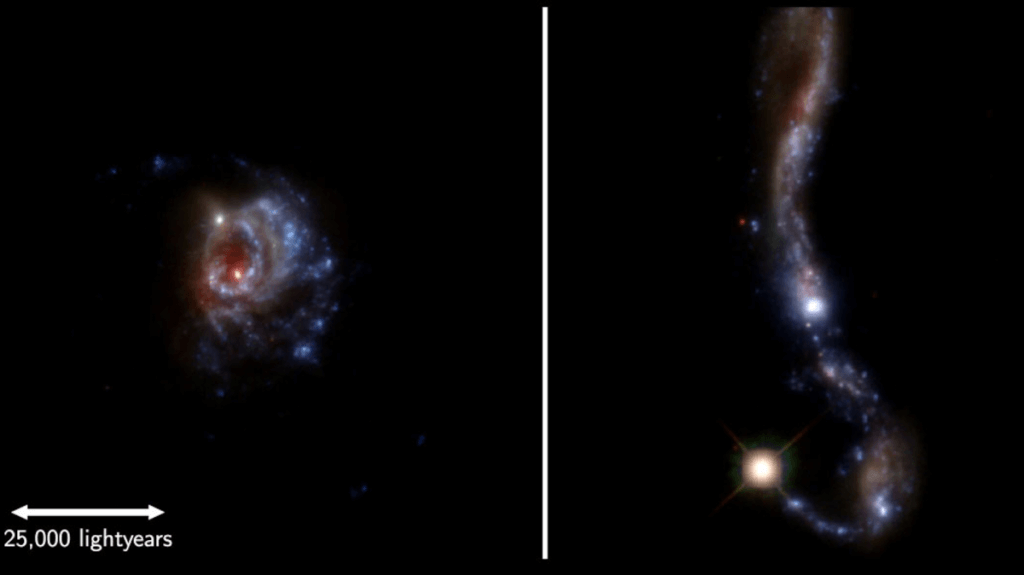
Milky Way’s cosmic neighbors help bring ancient galaxies into focus (Image Credit: Space.com)
Astronomers are spying on the Milky Way’s neighbors, assessing the amount of light that escapes from them and how this is connected to each galaxy’s physical properties.
This deep investigation of our local universe could help scientists better understand the early, distant galaxies currently being observed by the James Webb Space Telescope (JWST) and the Hubble Space Telescope.
Because galaxies in the early universe are incredibly faint and thus difficult to observe, a team of astronomers led by Jens Melinder of the University of Stockholm in Sweden set out to create a reference sample of galaxies in the neighborhood of our Milky Way.
Related: Galaxies: Collisions, types and how they’re made

In particular, Melinder and colleagues collected and collated data regarding a special wavelength of ultraviolet radiation from these local galaxies known as Lyman alpha light.
Lyman alpha light is found in the light from gas surrounding the hottest stars, which means it is found in star-forming galaxies in particular. The peak period of star formation in the universe occurred around 10 billion years ago, so Lyman alpha light is a great way of studying galaxies that existed when the universe was just four billion years old or so. (The Big Bang that created our universe occurred about 13.8 billion years ago.)
But decoding the information carried by this light can be difficult, as the path it takes to instruments like Hubble and the JWST is complex.
Lyman alpha light takes the scenic route around the cosmos
The exact wavelength of Lyman alpha light and the direction from which it travels are factors influenced by the physical processes it encounters as it makes its way out of its source galaxy. Regions of these galaxies with differing physical conditions through which Lyman alpha light travels can change the path of individual photons that make up the light, change their wavelength and even absorb a fraction of the light.
The fact that Lyman alpha light can encounter hot regions, or dusty areas, or sectors with strongly flowing gas clouds in their source galaxy and during its journey means that, by the time it reaches us, the information it carries can be difficult to interpret.
If an accurate interpretation of this light after its complicated journey is possible, however, it can reveal substantial amounts of information about the physical properties of the galaxies from which it originates.
To better understand these emissions and to build their Lyman Alpha Reference Sample (LARS), the team selected 45 local galaxies that are highly star-forming, observing them across the entire electromagnetic spectrum. This allowed the team to deduce how much Lyman alpha light escapes each galaxy, and how this fraction correlates with the physical properties of that galaxy.
One of the most important findings reached by the astronomers is the connection between how much gas, plasma (which is super-hot, electrically charged gas) and dust envelopes surround the galaxies they studied and the amount of Lyman alpha light that escapes them.
“There is a clear correlation between the amount of cosmic dust a galaxy has and how much Lyman it lets out,” Melinder said in a statement. “This was expected, because dust absorbs light, but now we have quantified the effect.”
The scientists were also able to determine how this gas is distributed in the galaxies and how it moves through them.
The team discovered a connection between the total mass of the stars in a galaxy with the amount of Lyman alpha light that is able to escape it, though this connection is less clear than the link between gas and the escape of this light.
What does not seem to be linked with Lyman alpha light escape in the galaxies, however, is the rate at which those galaxies are forming new stars.
Related: The early universe was crammed with stars 10,000 times the size of our sun, new study suggests
Lyman alpha light ‘shrinks’ galaxies
One thing the team found that could be particularly significant is the fact that, when observed in other wavelengths of light, these galaxies suddenly look considerably larger. This is an effect that has been seen before by astronomers.
“We see the same effect in computer simulations of galaxies with calculations of how Lyman alpha travels through the gaseous clouds in interstellar space,” team member Peter Laursen, a researcher at the Cosmic Dawn Center in Denmark, said in the same statement. “This confirms that we have a rather good theoretical understanding of the physics at play.”
This effect is important to consider when looking at early and distant galaxies, because the light from their outskirts can be too faint to detect or can fall beyond the limits of the detectors observing them. That means the examination and the quantification of this effect as seen in LARS could help astronomers better account for it, and thus more accurately determine the size of early galaxies.
“These results will help in interpreting observations of very distant, but similar, galaxies observed with the Hubble and James Webb space telescopes,” Melinder concluded. “Understanding the detailed astrophysics of this type of galaxy is crucial for developing theories of how the first galaxies formed and evolved.”
The team’s research was published earlier this month in the Astrophysical Journal Supplement Series.





